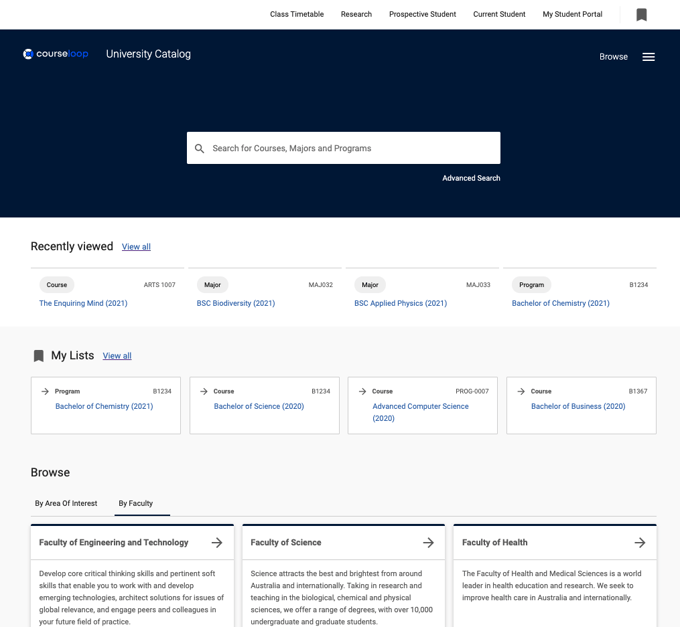Course catalog software: making curriculum digitally sleek
The number of universities using specialized course catalog software to publish their curriculum is trending. This, however, is a good thing.
But before we jump into it, let's clarify a few things.
The course catalog goes by many names. Depending on your university and its location, you might know it as a handbook, viewbook, guide, bulletin, calendar, or similar. For now, let’s call it the catalog.
Just as the name varies, each university has their own idea about what the catalog should and shouldn’t contain. Typically, though, it provides much of the fundamental information that students need to know about completing a particular degree at a particular university. For example, anything from course descriptions, admission requirements, faculties, life on campus, or university policy can often be found in the catalog.
Now that we are on the same page in general about what a catalog is, let’s talk about why it is so important and how course catalog software can improve your catalog experience.
Understanding the power of your catalog
Catalogs are a critical tool to communicate important university information to current students, prospective students, and employers. They play a key role in student recruitment and retention, ongoing student experience and success, as well as informing and supporting academic and administrative staff.
Poorly designed catalogs can cause unnecessary conflict with existing students and leave prospective students with a low perception of the university. However, the right course catalog software can save universities on academic and administrative overheads and create a harmonious experience for all involved.
Recruiting Students
Outside of parents, teachers, friends, university open days and school visits, where are prospective students getting their information from? The course catalog. You betcha! It could even be the first source of reliable information they receive, so it needs to be easy to find.
Since we've implemented the new handbook (catalog) with CourseLoop last year we had 700,000 hits on the handbook. 650,000 of those were not (current) students, they were staff, they were agents, they were prospective students. So it's one of our biggest recruiting tools.
John Reed, UNSW Director of Student Services and Systems (interview 2020)
Additionally, prospective students may even look more broadly to the expertise of the internet. Aside from league tables and rankings, there is a plethora of websites and blogs offering their wisdom on how to choose a course or university. Helpfully, most will direct prospective students to explore the university website. Many will even specify the course catalog as the first place to look.
In its tips for choosing a course, one course and university comparative website, Good Universities Guide, suggests that “the first step to success is reading the course handbook thoroughly…” Moreover, a search of the same site found 40 external links leading to different university degree finder and catalog sites.
This shows that when prospective students trawl through the flood of information they are likely to end up at the catalog—one way or another—so why not make the most of it. Course catalog software can support student recruitment. Benefits can include search engine optimization, intuitive navigation, searching and filtering options, accessibility, and a seamless blend with your brand.
Communicating curriculum and general information
Universities need to communicate their curriculum and other general information. The catalog provides a convenient way to do that. Herein lies an important point. Stakeholders will often rely upon the information contained in the catalog when making decisions. Consequently, this reliance means that any outdated or inaccurate information published to the catalog poses a risk to the university. And, of course, this often results in universities brandishing disclaimers.
Some governments have even legislated that the information published needs to be clear, accurate and accessible for students and prospective students to make informed decisions about their studies.
Failure to publish clear, accurate and accessible information to the catalog can be a source of conflict. We've all heard the horror story of the student who couldn't graduate because they relied on inaccurate information about their chosen course. On the other hand, a single source of truth paired with a complete version history, integrated and automated publishing can give universities the confidence to trust their catalog and even do away with the disclaimers.
Refining the catalog
Universities are in a global race to publish the best possible catalog using course catalog software. But software implementation is only one part. In their recent blog Constructive Guides or Confounding Relics? for Inside Higher Ed, Terry U. O'Banion and Cindy Miles say they found that community colleges have three key challenges when it comes to their catalog: excess span and scope, unbounded choice, and ambiguity of purpose.
This is a timely reminder for us all to ask ourselves what we need to communicate and why. Updating the course catalog with a software solution creates the perfect opportunity to clean out the clutter. For example, an easy to read catalog with a modern design can only help searchers cut through the forest of information and find what they are looking for.
Preparing for Generation Alpha
Finally, the arrival of Generation Alpha into higher education in the latter half of the decade might be by far the most compelling reason for universities to digitally transform their catalog. Alphas are the only generation to be born both wholly in the 21st century and their digital proficiency, like their gaming level, is expert.
In their book Generation Alpha (2021), social research experts Mark McCrindle & Ashley Fell call Alphas ‘digital natives’. They predict Alphas to be the most educated generation yet. Additionally, they say that many of the jobs Alphas will find themselves in don’t even exist yet. Accordingly, this means that universities will need course catalog software to achieve the operational efficiency to get new curriculum to market at speed.
This futuristic cohort already has wicked fast digital abilities. Therefore, universities who prepare themselves now with a digitally sleek and engaging catalog will be appealing. Conversely, anyone who doesn’t live up to Gen Alpha's digital expectations risks becoming obsolete.
A simply better catalog solution

With CourseLoop's course catalog software solution, our clients have:
- a definitive source of truth,
- a complete version history,
- integrated and automated catalog publishing,
- extensive catalog search & browse capabilities, and
- an intuitive navigation & modern, accessible design consistent with their banding.
Main photo credit - Ilyuza Mingazova on Unsplash.

